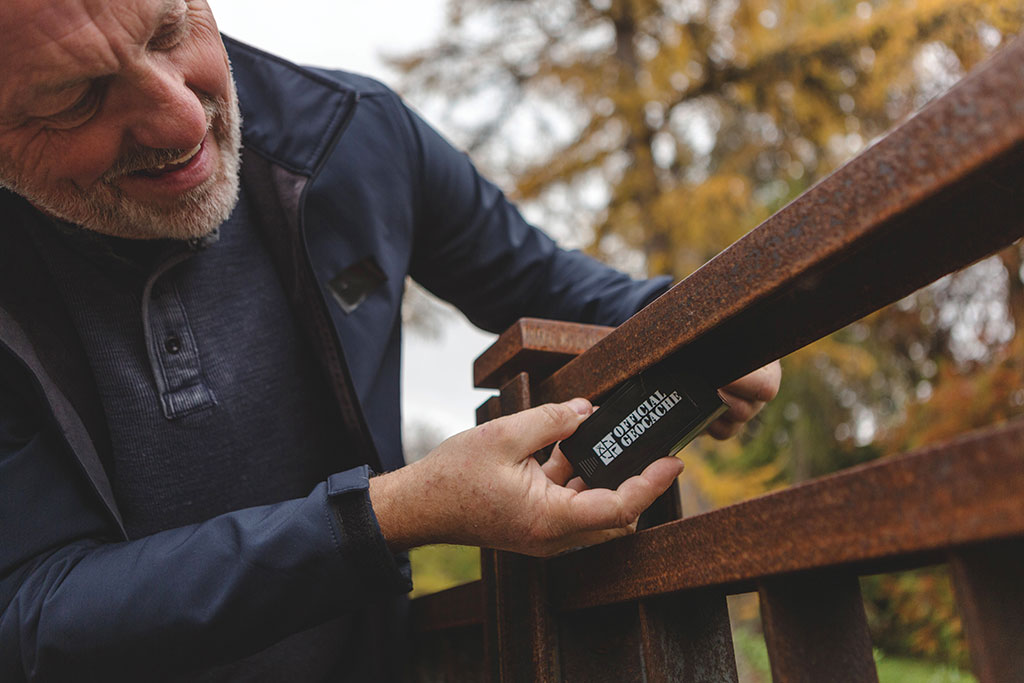Geocaching: A Global Scavenger Hunt

Scavenger hunts have long been a cherished pursuit, awakening the thrill-seeking desire of children and adults alike.
When an enigmatic “X” marks the spot, many feel the call to action, prompting them to chart a course, assemble their provisions, and set sail—whether on a tangible vessel or one conjured by the depths of their imagination—all in pursuit of the coveted treasure. While such adventures are fewer and farther between as we grow up, there’s still at least one way to experience them: through the engaging activity of geocaching, the very real hunt for treasures hidden around the globe.

What is geocaching?
high-tech game of hide-and-seek, where someone hides a container for others to find,” says Chris Ronan, senior PR manager for Geocaching HQ. It all started in 2000 when a man named Dave Ulmer sought a way to test the accuracy of GPS signals after the public gained access to them. “He hid a container, marked the coordinates, and put the information online, challenging anyone to find it,” Ronan shares. Someone did three days later, and thus geocaching was born. Four months following that initial hunt, cofounders Jeremy Irish, Bryan Roth, and Elias Alvord created Geocaching.com, which allowed people around the world to list where they had placed containers so others could search for them.
Now, twenty-four years later, there are more than 3.3 million geocaches concealed in over 190 countries around the world. Geocaching.com and its official application make it easier than ever for people to participate—all you need to play is a phone. Because the heart of the activity is so simple, it’s a great way for people to engage with other treasure hunters as well as with nature. As Ronan notes, “Geocaching offers a way to take what you enjoy, be it hiking, exploring, camping, or photography, and add a new level of interest by directing people to uncover hidden stories and locations.”

The hunting process
To start, someone will place a container somewhere in the world and post the coordinates and details on Geocaching.com; other players will then use the Geocaching app or website to find the container. There are several hiding guidelines to follow if you’re placing a new geocache, including having the landowner’s permission, not burying the container, and adhering to all legal standards and local laws. Otherwise, you can have fun with it. “And, yes, underwater—if it meets the requirements—is also in play,” adds Ronan.
Whenever you find a geocache, you sign the accompanying logbook, re-hide the container, and share your experience online. You read that right. You don’t keep the geocache but instead put it back in the exact spot you found it so others can look for it as well. But by recording the find, both in the physical logbook within the container and on the app, you prove that you located it and can move on to your next gem.
There are many different types of containers around the world with the most common being a traditional cache, which is located at specific coordinates and may contain a small item that you can swap for an item of equal value. You may also encounter mystery caches that require you to solve a puzzle to unlock the coordinates, multi-caches that involve two or more locations, and many other variants. Ronan clarifies that the geocaches range in complexity; in fact, the owners have to rate both the difficulty and the terrain on a scale of one to five. “Players can choose which geocaches are the best fit for them,” he explains, “but we suggest that beginners start with a level one terrain and level one difficulty cache to ensure a good start.”

A thrilling adventure
The allure of finding one of millions of geocaches around the world keeps people coming back for more. “In 2008, I received a handheld GPS, and from the moment I found my first geocache, I was absolutely hooked,” says Joshua Johnson, also known as the Geocaching Vlogger. “As a child of the ’80s, I have a deep affection for the movie The Goonies, so when I discovered that geocaching offered a global scavenger hunt experience, I knew I had to jump right in.” He’s now found close to 8,000 geocaches and continues to document his adventures for his 800,000 online followers. On top of his video content, Johnson shares about his travels through his podcast, Treasures of Our Town, and his comic book, The Greatest Treasure.
While geocaching is not a new activity, the rise of social media platforms like TikTok has led more people to discover it through content like Johnson’s. “In 2020, with the need for safe and enjoyable outdoor activities, countless individuals sought ways to have fun while maintaining social distancing,” Johnson shares. With so many geocaches located on every continent, it continues to be a great pursuit for people of all ages. As Johnson says, “You need a good dose of adventure.” His hunts have taken him to the jungles of Brazil in search of a rare geocache and sent him repelling off the side of a cliff.
The possibilities extend even farther. “There’s actually a geocache hidden beside a hydrothermal vent at the seafloor 2,300 meters down,” says Ronan. There’s also one hidden on the International Space Station! Though you may not be able to travel deep into the ocean or up into space, there may be dozens of containers right in your area just waiting to be found. Johnson notes that there are always new adventures to unlock: “There will never be a lack of the possibilities to find more geocaches in more interesting places.” You just have to get out and look for them.
For more info, visit geocaching.com
24 Views




